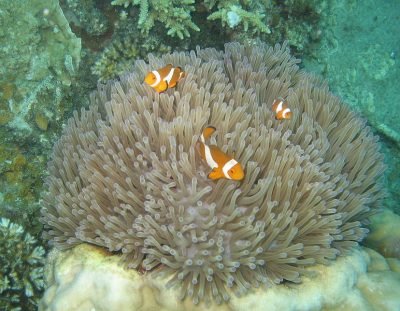Clownfish
Clownfish Sounds (Amphipiron sp.)
Description

Clownfish are tropical fishes that live in small, social groups in association with sea anemones (the above shows a common clownfish, Amphiprion ocellaris, in the sea anemone, Heteractis magnifica). “Chirp” and “pop” sounds are produced during agonistic interactions between large fish and their smaller conspecifics . These interactions help maintain the size-based dominance hierarchy of the group. Imaged credit: Pulau Perhentian Besar, Malaysia used under Creative Commons Attribution-Share Alike 3.0 Unported license.
Clownfish are tropical marine fishes found in the warmer waters of the Indian and Pacific ocean basins. There are 28 species of clownfish whose body coloration varies from yellow, orange, or red/black with white vertical bars or patches. The largest clownfish species can reach 18 cm (7.1 in) while the smallest measure 10 cm (3.9 in).
Clownfish live in small colonies within a host anemone. The clownfish and anemone share a symbiotic relationship, where both animals benefit. The clownfish are grouped into breeding male/female pairs and multiple non-breeding, juvenile males. The largest and dominant is the breeding female; the next largest fish is the breeding male. If the female of a group dies, the largest male changes sex to become a breeding female.
Clownfish produce sounds during agonistic interactions that help maintain the size-based hierarchy of clownfish social groups. Larger, dominant clownfish, particularly the larger females, produce distinct “chirp” and “pop” sounds while charging and chasing smaller subordinates. The sounds are produced when the jaw teeth clash, as the jaw rapidly slams shut. Chirps on average last 89 ms and contain multiple pluses of different durations. Subordinate males do not produce chirps or pops. Instead, subordinates produce hydrodynamic sounds generated by continuous head shaking. It is thought this shaking behavior serves as a way to avoid physical injury during agonistic interactions.
Clownfish hearing studies have shown they can detect sounds between 75 and 1800 Hz, with best hearing sensitivities between 95 and 240 Hz. The dominant frequency of sounds produced by clownfish ranges from 370-900 Hz. Dominant frequency and pulse length of sounds are strongly correlated with clownfish size; larger individuals produce lower frequency and longer duration pulses than smaller individuals.
Additional Resources
- Wikipedia, Amphiprioninae.
References
- Buston, P. (2003). Size and growth modification in clownfish: Social hierarchies. Nature, 424(6945), 145–146. https://doi.org/10.1038/424145a
- Chen, K.-C., & Mok, H.-K. (1987). Sound production in the anemonefishes, Amphiprion clarkia and A. frenatus(Pomacentridae), in captivity. Japanese Journal of Ichthyology, 35(1), 90–97.
- Colleye, O., Frederich, B., Vandewalle, P., Casadevall, M., & Parmentier, E. (2009). Agonistic sounds in the skunk clownfish Amphiprion akallopisos : Size-related variation in acoustic features. Journal of Fish Biology, 75(4), 908–916. https://doi.org/10.1111/j.1095-8649.2009.02316.x
- Colleye, O., & Parmentier, E. (2012). Overview on the diversity of sounds produced by clownfishes (Pomacentridae): Importance of acoustic signals in their peculiar way of life. PLoS ONE, 7(11), e49179. https://doi.org/10.1371/journal.pone.0049179
- Colleye, O., Nakamura, M., Frederich, B., & Parmentier, E. (2012). Further insight into the sound-producing mechanism of clownfishes: What structure is involved in sound radiation? Journal of Experimental Biology, 215(13), 2192–2202. https://doi.org/10.1242/jeb.067124
- Colleye, O., Vandewalle, P., Lanterbecq, D., Lecchini, D., & Parmentier, E. (2011). Interspecific variation of calls in clownfishes: Degree of similarity in closely related species. BMC Evolutionary Biology, 11(1), 365. https://doi.org/10.1186/1471-2148-11-365
- Fautin, D. G. (1991). The anemonefish symbiosis: What is known and what is not. Symbiosis, 10, 23–46.
- Davenport, D., & Norris, K. S. (1958). Observations on the symbiosis of the sea anemone stoichactis and the pomacentrid fish, Amphiprion percula. The Biological Bulletin, 115(3), 397–410. https://doi.org/10.2307/1539105
- Olivier, D., Frédérich, B., Herrel, A., & Parmentier, E. (2015). A morphological novelty for feeding and sound production in the yellowtail clownfish: Feeding and sound production in clownfish. Journal of Experimental Zoology Part A: Ecological Genetics and Physiology, 323(4), 227–238. https://doi.org/10.1002/jez.1907
- Parmentier, E., Lagardere, J. ., Vandewalle, P., & Fine, M. . (2005). Geographical variation in sound production in the anemonefish Amphiprion akallopisos. Proceedings of the Royal Society B: Biological Sciences, 272(1573), 1697–1703. https://doi.org/10.1098/rspb.2005.3146
- Parmentier, E., Colleye, O., & Mann, D. (2009). Hearing ability in three clownfish species. Journal of Experimental Biology, 212(13), 2023–2026. https://doi.org/10.1242/jeb.030270